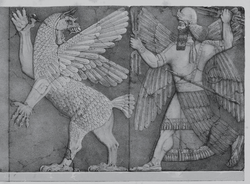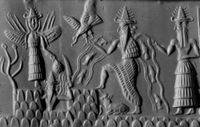جلو

| جزء من سلسلة مقالات عن |
| ديانة الرافدين |
|---|
|
|
في الديانات السومرية والرافدين القديمة، گـلـّوس gallûs[1] (also called gallas;[2] الأكدية gallû < السومرية gal.lu) كانوا عفاريت أو devil عظيمة من ancient Mesopotamian Underworld.
الدور في الأساطير
Gallu demons hauled unfortunate victims off to the underworld. They were one of seven devils (or "the offspring of hell") of Babylonian theology that could be appeased by the sacrifice of a lamb at their altars.[3]
The goddess Inanna was pursued by gallu demons after being escorted from the Underworld by Galatura and Kuryara.[4][3] In the Descent, it is stated that said demons “know no food, know no drink, eat no flour offering, drink no libation. They never enjoy the pleasures of marital embrace, never have any sweet children to kiss. They snatch the son from a man’s knee. They make the bride leave the house of her father in law”.[5] An especially fierce gallu demon, the monstrous Asag, was slain by Ninurta using the enchanted mace Sharur.
استخدامات أخرى
The word gallu may also refer to a human adversary, one that is dangerous and implacable.[6]
انظر أيضاً
المراجع
- ^ Morris, John (1880). The new nation. Original from Oxford University. pp. 40& 311 (volume 3 of 5).
Gallu demon.
{{cite book}}: CS1 maint: location missing publisher (link) - ^ Muss-Arnolt, William (1905). A Concise Dictionary of the Assyrian Language. Original from Harvard University: Reuther & Reichard; Lemcke & Büchner; etc., etc. p. 216.
- ^ أ ب Briggs, Charles August; Toy, Crawford Howell (1911). Essays in Modern Theology and Related Subjects. Original from Harvard University: C. Scribner's sons. pp. 155–158.
Gallu demon.
- ^ Black, Jeremy; Cunningham, Graham; Flückiger-Hawker, Esther; Robson, Eleanor; Taylor, John; Zólyomi, Gábor. "Inana's descent to the netherworld". Electronic Text Corpus of Sumerian Literature. Oxford University. Retrieved 22 June 2017.
- ^ "Archival view of P468903". Cuneiform Digital Library Initiative. UCLA.
- ^ I. Tzvi Abusch Babylonian Witchcraft Literature: Case Studies 1987 "...especially, the initial position which he occupies in both support the propriety of our earlier analysis of obv. 37-40 on the basis of the comparison "Contra AHw sv, gallu in this line refers not to a demon but to a human enemy..."

